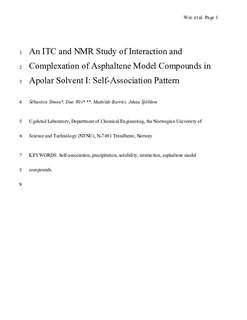| dc.contributor.author | Simon, Sebastien Charles | |
| dc.contributor.author | Wei, Duo | |
| dc.contributor.author | Barriet, Mathilde Isabelle | |
| dc.contributor.author | Sjøblom, Johan | |
| dc.date.accessioned | 2018-01-23T11:30:15Z | |
| dc.date.available | 2018-01-23T11:30:15Z | |
| dc.date.created | 2016-12-02T14:30:08Z | |
| dc.date.issued | 2016 | |
| dc.identifier.citation | Colloids and Surfaces A: Physicochemical and Engineering Aspects. 2016, 494 108-115. | nb_NO |
| dc.identifier.issn | 0927-7757 | |
| dc.identifier.uri | http://hdl.handle.net/11250/2479026 | |
| dc.description.abstract | The self-association pattern of asphaltene model compounds with different functional groups in xylene and mixtures of xylene and heptane have been studied by isothermal titration calorimetry (ITC) to shed new light on the association and interaction between components in the asphaltene fraction. The model compounds are N-(1-undecyldodecyl)-N′-(5-carboxylicpentyl)perylene-3,4,9,10-tetracarboxylbisimide (C5PeC11) and N,N′-bis(1-undecyldodecyl)perylene-3,4,9,10-tetracarboxylbisimide (BisAC11).
The results show that a combination of hydrogen bonding due to carboxylic groups and π–π stacking due to polyaromatic rings leads to higher association extent of C5PeC11 compared to that of BisAC11 in xylene. A dimerization model can well fit the association of both model compounds in xylene obtained both by ITC and NMR. Mixtures of C5PeC11 and BisAC11 can well quantitatively fit the features of self-association of real extracted asphaltenes probed by ITC. This could mean that the total asphaltene fractions are composed of polydisperse compounds displaying very different association properties.
Finally, increasing the heptane content in the solvent results in higher extent of π–π stacking between C5PeC11 molecules, which indicate formation of larger aggregates or tighter arrangement of aromatic rings. | nb_NO |
| dc.language.iso | eng | nb_NO |
| dc.publisher | Elsevier | nb_NO |
| dc.rights | Attribution-NonCommercial-NoDerivatives 4.0 Internasjonal | * |
| dc.rights.uri | http://creativecommons.org/licenses/by-nc-nd/4.0/deed.no | * |
| dc.title | An ITC and NMR study of interaction and complexation of asphaltene model compounds in apolar solvent I: Self-association pattern | nb_NO |
| dc.type | Journal article | nb_NO |
| dc.type | Peer reviewed | nb_NO |
| dc.description.version | acceptedVersion | nb_NO |
| dc.source.pagenumber | 108-115 | nb_NO |
| dc.source.volume | 494 | nb_NO |
| dc.source.journal | Colloids and Surfaces A: Physicochemical and Engineering Aspects | nb_NO |
| dc.identifier.doi | 10.1016/j.colsurfa.2016.01.018 | |
| dc.identifier.cristin | 1407713 | |
| dc.relation.project | Norges forskningsråd: 234112 | nb_NO |
| dc.description.localcode | © 2016. This is the authors’ accepted and refereed manuscript to the article. This manuscript version is made available under the CC-BY-NC-ND 4.0 license http://creativecommons.org/licenses/by-nc-nd/4.0/ | nb_NO |
| cristin.unitcode | 194,66,30,0 | |
| cristin.unitname | Institutt for kjemisk prosessteknologi | |
| cristin.ispublished | true | |
| cristin.fulltext | original | |
| cristin.fulltext | postprint | |
| cristin.qualitycode | 1 | |

